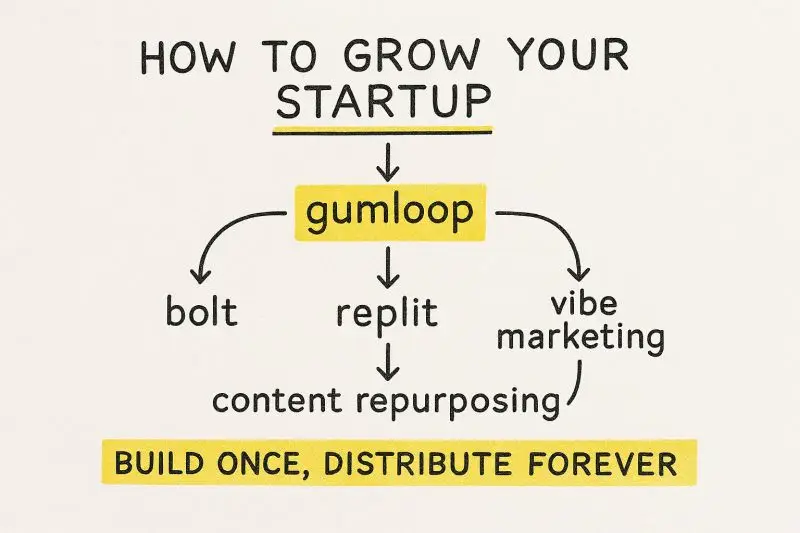The AI-powered startup growth playbook: Greg Isenberg's 7-step framework
Learn Greg Isenberg's 7-step framework for growing startups using AI tools, vibe marketing, and content repurposing to acquire customers efficiently.

Greg Isenberg, CEO of Late Checkout (a portfolio of internet companies), recently shared a comprehensive strategy for growing startups using AI, agents, and "vibe marketing." His approach combines cutting-edge AI tools with strategic marketing fundamentals to help startups acquire and retain customers more efficiently.
Late Checkout, founded by Isenberg in 2020, is a product studio that specializes in acquiring, building, and scaling community-focused internet products and companies. The studio has gained recognition for its approach of identifying undervalued online communities and transforming them into thriving digital businesses. Notable in their portfolio is Islands, a platform for creating community spaces that Late Checkout acquired in 2021, and their investment in Read.cv, a professional network for creative professionals.
Here's a breakdown of Isenberg's seven-part framework that can help founders acquire customers and scale faster in today's AI-enhanced landscape.
1. Build a lead generation machine
The foundation of Isenberg's approach starts with creating scalable ways to attract potential customers:
"First, I'd build a lead gen machine: launch directories people search for (ex: 'companies using X') using gumloop + keyword planner," Isenberg explains.
This strategy leverages tools like Gumloop to create searchable directories that serve as magnets for your ideal customers. For example, if you're selling a Slack alternative, creating a directory of "Companies using Slack" could attract precisely the audience you want to reach.
Other key lead generation tactics include:
- Creating knowledge bases via ChatGPT-4o that answer common customer questions
- Developing micro-tools that solve specific industry pain points using platforms like Replit or Bolt
- Analyzing successful content formats in your niche using AI tools like Claude and Perplexity, then adapting them to your audience
- Co-branding tools with adjacent players to tap into their audiences
- Running "reverse webinars" where the audience brings problems and you solve them live
This approach aligns with Zebracat’s marketing statistics post[2], which found that businesses using AI-powered lead generation and qualification tools see more than 30% reduction in customer acquisition costs.

2. Automate the boring stuff
After establishing lead generation channels, Isenberg recommends automating repetitive tasks to free up resources for higher-value activities:
His automation strategy includes:
- Using Lindy AI for scheduling, email outreach, and follow-ups
- Implementing Gumloop for referral systems and lead magnet distribution
- Leveraging tools like Swell, Opus Clip, and Blotato to transform one video into multiple content formats
- Creating AI-powered microsites for each customer persona using Typedream, Durable, or Bolt
- Setting up systems to automatically post social proof as it happens
- Using Zapier with ChatGPT to surface and share customer milestones
CoSchedule’s data[3] supports this approach, finding that marketing teams using AI report saving approximately 5 hours per team member weekly—time that can be redirected to strategy and creative work.
3. Implement "vibe marketing"
Isenberg places significant emphasis on what he calls "vibe marketing"—creating a distinctive brand feeling that resonates with your target audience:
"Next is vibe marketing. Find content that's already winning (sort by bookmarks, comments etc). Amplify with paid ads to lookalikes."
His vibe marketing playbook includes:
- Identifying successful content by analyzing engagement metrics across platforms
- Amplifying proven content with paid advertising to similar audiences
- Creating "content triplets" from every successful piece: turning one idea into a thread, blog post, and video
- Strategically running paid social to boost organic content
- Maintaining an active presence on social platforms where your audience engages
- Running solution-focused webinars for B2B audiences that solve real problems before pitching
- Developing scroll-stopping visuals using AI tools like ChatGPT-4o images, Midjourney, and Ideogram
4. Become a testing machine
Isenberg advocates for systematic, high-volume testing to quickly identify what resonates with your audience:
"If you're not shipping 10+ hooks a day and letting the algo tell you which one wins, you're leaving traction on the table."
His testing approach includes:
- Consistently shipping multiple content hooks daily to identify winners
- Using tools like Gumloop or ScraperAPI to scrape Reddit, YouTube, and Twitter for trending content in your niche
- Feeding gathered content to ChatGPT-4o to generate dozens of potential social media threads or ad angles
- Using Claude to summarize patterns across successful content
- Employing ChatGPT Vision to analyze top-performing landing pages
- Treating distribution as a data-driven problem rather than a creative guessing game
5. Deploy lead magnets consistently
Beyond testing, Isenberg recommends regularly releasing valuable lead magnets to capture audience information:
"I'd also drop 2+ lead magnets/month: niche communities, private databases, AI-powered industry reports, calculators, ebooks, spreadsheet → web apps."
His lead magnet strategy focuses on creating high-value resources that potential customers are willing to exchange their information to access:
- Building niche communities on platforms like Circle or Skool
- Creating private databases via Airtable or Gumroad
- Generating AI-powered industry reports using Claude
- Developing calculators, ebooks, and web applications that solve specific problems
- Emphasizing actual value over vanity metrics: "Value over vanity," as Isenberg puts it
6. Repurpose content systematically
Isenberg strongly advocates for systematic content repurposing to maximize the return on content creation efforts:
"And I'd repurpose like a crazy person. 1 insight becomes a blog, video, tweet, template, and microsite."
His repurposing strategy includes:
- Transforming each insight into multiple content formats
- Using tools like Bolt or Replit to quickly prototype and ship content
- Converting customer feedback into public-facing content using Typeform and ChatGPT
- Creating templates for recurring content types
- Adopting a "build once, distribute forever" mindset
Content Marketing Institute’s report[4] supports this approach, finding that content repurposed across multiple channels experience a 72% increase in engagement.
7. Leverage AI to do more with less
The overarching theme of Isenberg's framework is using AI to accomplish more with fewer resources:
"AI and agents let you do what used to take 10 people. But you still need to know what to build and who it's for."
While AI tools can dramatically expand a small team's capabilities, Isenberg emphasizes that they must be guided by strategic thinking about product-market fit and audience needs. The technology amplifies execution but doesn't replace strategic clarity.
The bottom line

Isenberg's framework offers a comprehensive roadmap for startups looking to leverage AI and strategic marketing for growth. By combining lead generation, automation, distinctive branding, systematic testing, valuable lead magnets, content repurposing, and AI augmentation, startups can build sustainable growth engines.
As Isenberg concludes: "That's how I'd grow a startup today."
For those interested in exploring these concepts further, Isenberg offers free "vibe marketing" workflows weekly at The Vibe Marketer.
Source
[1] Orbit Media (Blogging Statistics) Orbit Media Studios. (n.d.). Blogging statistics and trends: The 2023 survey of 1000+ bloggers. https://www.orbitmedia.com/blog/blogging-statistics/
[2] Zebracat (AI Marketing Statistics) Zebracat. (n.d.). 45+ AI marketing statistics you need to know in 2024. https://www.zebracat.ai/post/ai-marketing-statistics
[3] CoSchedule (AI Marketing Statistics) CoSchedule. (n.d.). AI marketing statistics: What the data says about AI in content and marketing. https://coschedule.com/ai-marketing-statistics
[4] Search Engine Watch (Content Repurposing for SEO) Search Engine Watch. (n.d.). How repurposing long-form content across digital platforms maximizes SEO impact. https://searchenginewatch.com/p/how-repurposing-long-form-content-across-digital-platforms-maximizes-seo-impact




